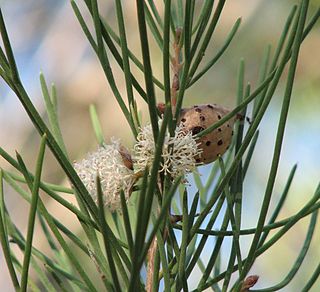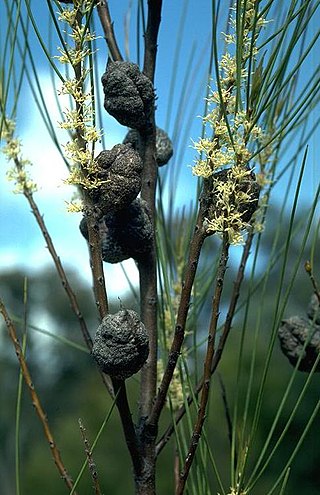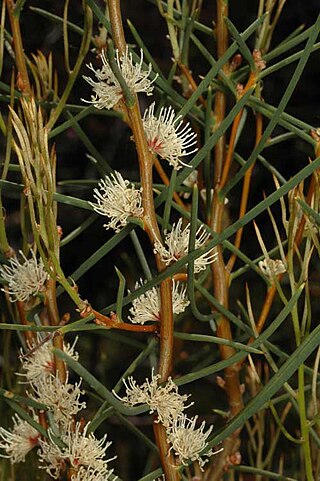
Hakea is a genus of about 150 species of flowering plants in the family Proteaceae, endemic to Australia. They are shrubs or small trees with leaves that are sometimes flat, otherwise circular in cross section in which case they are sometimes divided. The flowers are usually arranged in groups in leaf axils and resemble those of other genera, especially Grevillea. Hakeas have woody fruit which distinguishes them from grevilleas which have non-woody fruit which release the seeds as they mature. Hakeas are found in every state of Australia with the highest species diversity being found in the south west of Western Australia.

Hakea scoparia is a species of flowering plant in the family Proteaceae and is endemic to the south-west of Western Australia where it grows in shrubland. It is a shrub with ascending branches, terete leaves and clusters of cream to pinkish flowers in leaf axils from June to September.

Hakea drupacea, commonly known as sweet-scented hakea, is a tree or shrub which is native to south west Western Australia.

Hakea teretifolia, commonly known as the dagger hakea, is a species of woody shrub of the family Proteaceae and is common on heathlands in coastal eastern Australia from northern New South Wales through to Victoria and Tasmania. A very prickly shrub, it is rarely cultivated but easy to grow.

Hakea decurrens, commonly known as bushy needlewood, is a species of shrub or small tree in the family Proteaceae.

Hakea undulata, commonly known as wavy-leaved hakea, is a flowering plant in the family Proteaceae and is endemic to the south-west of Western Australia. It has stiff wavy leaves and fragrant cream-white flowers from mid-winter to October.

Hakea cristata, commonly known as the snail hakea, is a shrub in the family Proteaceae native to Western Australia. An ornamental prickly shrub with attractive foliage and creamy white rounded flowers appearing in profusion in the winter months.

Hakea pulvinifera, also known as Lake Keepit Hakea, is a small, prickly shrub in the family Proteaceae, found only on one rocky hillside at Lake Keepit near Gunnedah in New South Wales, Australia. The species was first described in 1962, believed extinct in 1971 and rediscovered in 1988. The entire species may be of only one genetically unique individual. It is one of only two Hakea species that reproduce solely through basal shoots or 'suckering', reducing genetic variation.

Hakea dohertyi, commonly known as the Kowmung hakea, is a shrub endemic to a restricted locale in the Great Dividing Range in central New South Wales in Australia.

Hakea mitchellii, commonly known as desert hakea, is a shrub species in the family Proteaceae.

Hakea aculeata, commonly known as the column hakea, is a vulnerable species of the family Proteaceae found in the Wheatbelt region of Western Australia. An unusual sculptural species with dense columns of prickly foliage and plentiful clusters of strongly scented blooms in spring.
Hakea acuminata is a shrub of the family Proteaceae native to Western Australia. A restricted species bearing clusters of white flowers with a green or pinkish tinge in late autumn to winter.

Hakea bicornata is a shrub in the family Proteaceae native to Western Australia, with attractive creamy-white flowers and fruit with two distinctive horns.

Hakea ilicifolia is an open shrub or tree in the family Proteaceae and is endemic to Western Australia. It is a small, dense shrub with stiff, lobed leaves and clusters of yellow or creamy-white flowers.

Hakea lissocarpha, commonly known as honey bush or the duck and drake bush, is a shrub of the genus Hakea native to a large area in the Mid West, Wheatbelt, Peel, South West, Great Southern and Goldfields-Esperance regions of Western Australia.

Hakea megalosperma, commonly known as Lesueur hakea, is a shrub of the genus Hakea native to a small area along the west coast in the Wheatbelt region of Western Australia. It is a small shrub with sweetly fragrant white or pink flowers, darkening as they age to red and thick egg-shaped bluish-green leaves.

Hakea meisneriana is a shrub in the family Proteaceae and is endemic to Western Australia. It has small, nectar rich, creamy white flowers in clusters in the upper branches from August to November.

Hakea stenophylla is a shrub or tree in the family Proteaceae, with sweetly scented creamy-white flowers. It is endemic to Western Australia.

Hakea fraseri, the corkwood oak, is a species of shrub or small tree in the family Proteaceae and is endemic to northern New South Wales. It has furrowed bark, pendulous foliage and creamy-white flowers in spring.

Hakea oldfieldii is a shrub of the family Proteaceae and is endemic to South West region of Western Australia. It has small white or cream-yellow flowers in profusion in spring.





















